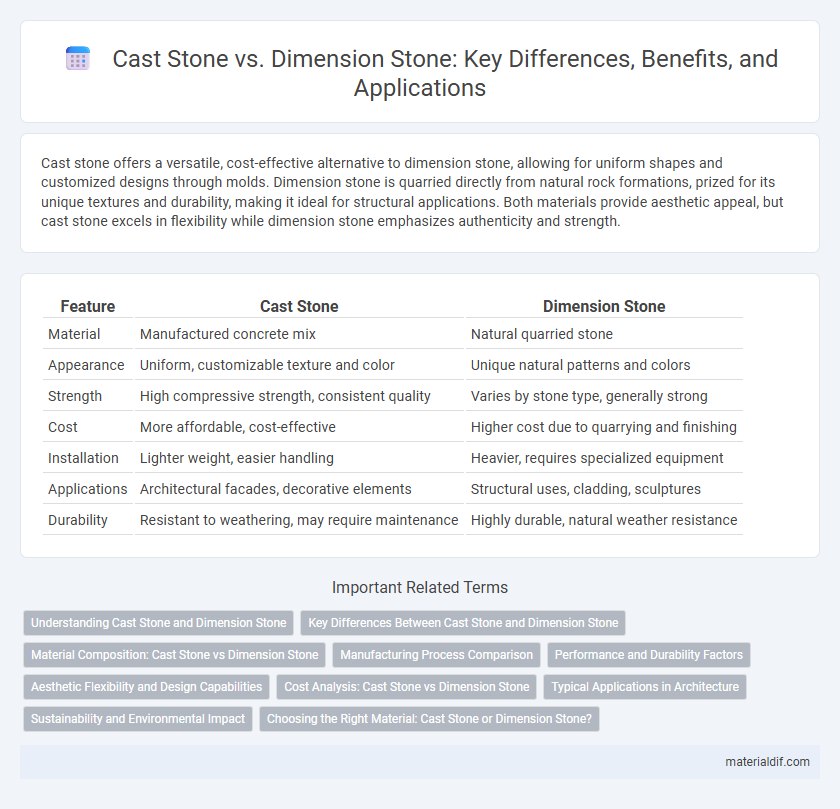Cast stone offers a versatile, cost-effective alternative to dimension stone, allowing for uniform shapes and customized designs through molds. Dimension stone is quarried directly from natural rock formations, prized for its unique textures and durability, making it ideal for structural applications. Both materials provide aesthetic appeal, but cast stone excels in flexibility while dimension stone emphasizes authenticity and strength.
Table of Comparison
| Feature | Cast Stone | Dimension Stone |
|---|---|---|
| Material | Manufactured concrete mix | Natural quarried stone |
| Appearance | Uniform, customizable texture and color | Unique natural patterns and colors |
| Strength | High compressive strength, consistent quality | Varies by stone type, generally strong |
| Cost | More affordable, cost-effective | Higher cost due to quarrying and finishing |
| Installation | Lighter weight, easier handling | Heavier, requires specialized equipment |
| Applications | Architectural facades, decorative elements | Structural uses, cladding, sculptures |
| Durability | Resistant to weathering, may require maintenance | Highly durable, natural weather resistance |
Understanding Cast Stone and Dimension Stone
Cast stone is a versatile, manufactured concrete product designed to simulate natural stone with consistent texture and color, commonly used in architectural features and decorative elements. Dimension stone refers to natural stone that has been quarried, cut, and finished to specific sizes for use in construction and cladding, prized for its unique natural patterns and durability. Understanding the differences between cast stone and dimension stone involves recognizing cast stone's cost-effectiveness and uniformity versus dimension stone's authenticity and natural variability.
Key Differences Between Cast Stone and Dimension Stone
Cast stone is a man-made concrete product designed to simulate natural dimension stone, offering uniformity in shape, color, and texture, whereas dimension stone is quarried natural stone cut into specific sizes and shapes. Key differences include cast stone's enhanced versatility and cost-effectiveness versus dimension stone's superior natural durability and unique aesthetic variations. Dimension stone typically requires minimal finishing after quarrying, while cast stone allows for customizable designs and intricate architectural detailing through molds.
Material Composition: Cast Stone vs Dimension Stone
Cast stone is an engineered masonry product composed primarily of cement, aggregates, and mineral oxides that replicate natural stone's appearance. Dimension stone, in contrast, consists of natural rock slabs directly quarried from formations such as granite, limestone, or sandstone, with inherent mineralogical composition and texture. The synthetic nature of cast stone allows customization in color and texture, while dimension stone retains the unique geological features and durability of the original stone.
Manufacturing Process Comparison
Cast stone is manufactured by mixing ground natural stone with cement, pigments, and aggregates, then molded and cured to achieve uniform shapes and textures. Dimension stone is quarried directly from natural rock formations and cut to size, preserving its inherent natural grain and color variations. The controlled casting process of cast stone allows for greater customization and consistency, while dimension stone maintains authentic geological characteristics through minimally processed extraction.
Performance and Durability Factors
Cast stone offers consistent performance due to its uniform manufacturing process, ensuring predictable strength and resistance to weathering. Dimension stone, being natural stone, presents variable durability depending on its geological composition, with some types like granite exhibiting superior hardness and longevity. Maintenance requirements also differ, as cast stone often withstands freeze-thaw cycles better, while dimension stone may require sealing to preserve its integrity.
Aesthetic Flexibility and Design Capabilities
Cast stone offers greater aesthetic flexibility with customizable shapes, textures, and colors achievable through molds and pigmentation, allowing unique architectural designs. Dimension stone, quarried in natural blocks, retains authentic stone character with limited shape alteration, emphasizing natural veining and color variations. Designers seeking precise replication of natural stone details prefer dimension stone, while those requiring intricate and uniform designs favor cast stone.
Cost Analysis: Cast Stone vs Dimension Stone
Cast stone offers a cost-effective alternative to dimension stone, with lower material and manufacturing expenses due to its molded production process. Dimension stone involves higher costs related to quarrying, cutting, and finishing natural stone slabs, making it more expensive for large-scale projects. Maintenance and transportation costs also tend to be lower for cast stone, enhancing its overall economic appeal in construction and architectural applications.
Typical Applications in Architecture
Cast stone is commonly used for decorative architectural elements such as window sills, cornices, and balustrades due to its versatility and ability to mimic natural stone. Dimension stone, prized for its natural appearance and durability, is typically employed in load-bearing structures, facades, and paving. Both materials play crucial roles in enhancing aesthetic appeal and structural integrity in architectural projects.
Sustainability and Environmental Impact
Cast stone offers a more sustainable option compared to dimension stone due to its lower quarrying impact and ability to incorporate recycled materials. Dimension stone extraction typically results in significant habitat disruption and higher carbon emissions from heavy machinery. The controlled manufacturing process of cast stone not only minimizes waste but also reduces energy consumption, enhancing its environmental performance.
Choosing the Right Material: Cast Stone or Dimension Stone?
Choosing between cast stone and dimension stone depends on project requirements including durability, aesthetics, and budget. Cast stone offers versatility and uniformity through its manufactured composition, making it ideal for intricate designs and cost-effective solutions. Dimension stone provides natural beauty and strength with unique textures and color variations, preferred for high-end architectural applications emphasizing authenticity.
Cast Stone vs Dimension Stone Infographic

 materialdif.com
materialdif.com